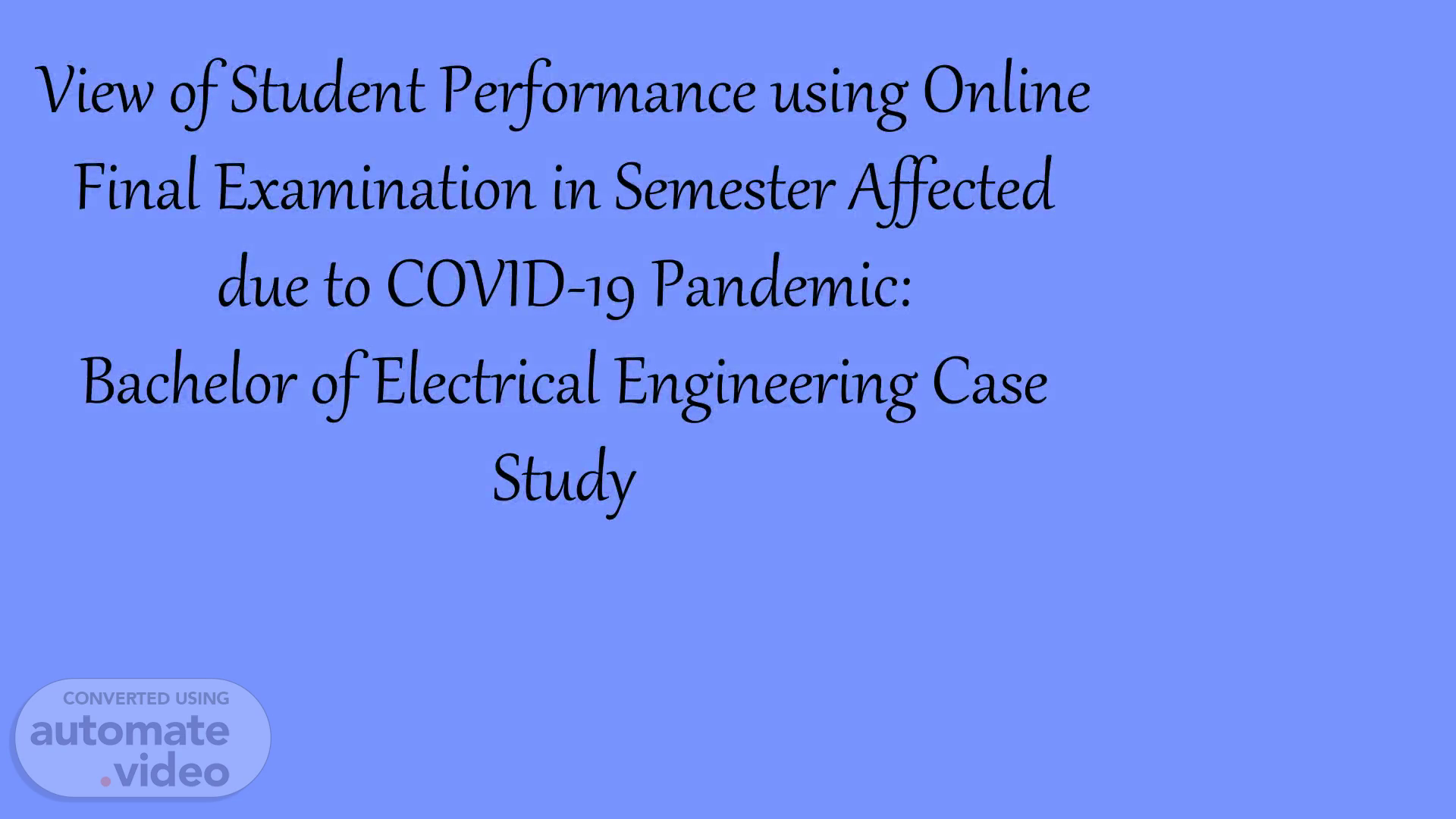
PowerPoint Presentation
Scene 1 (0s)
Maaspaliza Azri 1*, Azrita Alias 1 , 1 Center for Robotics & Industrial Automation ( CeRIA ), Faculty of Electrical Engineering, Universiti Teknikal Malaysia Melaka.
Scene 2 (40s)
ABSTRACT. Higher educational institutions have faced a variety of obstacles in their teaching and learning activities due to the COVID-19 pandemic. Particularly conducting online assessment during COVID-19 has posed extraordinary challenges for higher education institutions . To overcome this issue, the Faculty of Electrical Engineering took an obligatory approach that the evaluation of final examination assessment must contain 30 or more out of 100 marks open-ended (OE) or higher-order thinking skills (HOTS) questions to guarantee the quality of assessments in line with the objective of Outcome-Based Education (OBE). The paper presents the assessment’s results of the selected courses offered in semester 2 for the academic session 2018/2019 (no COVID-19 issue) and session 2019/2020 ( during COVID-19 issue) for the Bachelor Electrical Engineering (BEKG) program in the Faculty of Electrical Engineering (FKE), Universiti Teknikal Malaysia Melaka ( UTeM ). According to the findings, the distribution of grade success follows a standard bell shape , with most students receiving ordinary grades (B or B- )..
Scene 3 (2m 21s)
Introduction. The most critical part higher education institutions (HEI) is facing is how to conduct the assessment, especially the final examination. Many HEI has reported alternative approaches, such as take-home exams, time constrained assessments, pass/fail options, professional presentations, and E-portfolio [1,2 ]. To monitor and maintain the quality of online assessment during the COVID-19 pandemic, the strategy and some preventative approaches are being considered , such as virtual invigilation; however, this approach has a huge expense [3]. It is critical to adjust the technique of the evaluation following the distribution of grade achievement. Grading on a bell curve is a method of awarding grades in education that produces a desirable distribution of grades among a class's students [6]..
Scene 4 (3m 33s)
Problem Statement. Particularly conducting online assessment during COVID-19 has posed extraordinary challenges for higher education institutions.
Scene 5 (3m 50s)
Objectives. The First Objective. 1. 2. 3. The Second Objective.
Scene 6 (4m 30s)
Hypothesis. 1) What is the appropriate method to control the quality of grade assessment’s results during the COVID-19 pandemic situation???.
Scene 7 (4m 44s)
Methodology. Quantitative Method. Qualitative Method.
Scene 8 (5m 41s)
Implementation. Phase 1 All the core program courses in BEKG must have 30 marks (or more) out of 100 HOTS or OE in the final examination question . It contributes 18% (or more) of total marks.
Scene 9 (6m 43s)
Results. The evaluation oh the two academic sessions in semester 2, 2018/2019, and Semester 2, 2019/2020 as consideration of non-COVID-19 and COVID-19 situation. Overall, the standard normal distribution of grades is presented..
Scene 10 (7m 25s)
The Second Analysis of Obtained Results For course BEKG 2433, as shown in Figure 3, grade B contribute 25.4% during the COVID-19 pandemic and 10.7% before the COVID-19 incident..
Scene 11 (8m 26s)
Conclusion. Based on the discussion and findings, it was evident that improving method assessment in the final examination by employing HOTS and OE questions can results in a standard bell shape in the current COVID-19 pandemic. The majority of students receive an average grade (B or B-), with a smaller percentage receiving a B+ or C, and the lower proportion of studentsreceive a grade E or an A. This demonstrates that the suggested technique (30% of HOTS or OE questions in the final examination) will allow students to be screened based on their performance in comparison to their classmates. In the future, at least 30% marks of the final examination questions contain of HOTS and OE will be implemented, in order to increase the quality of students' performance..
Scene 12 (9m 40s)
References. Psychology 121. [1] Kelum A.A. Gamage , Erandika K. de Silva & Nanda Gunawardhana (2020). Online Delivery and Assessment during COVID-19: Safeguarding Academic Integrity, Educ. Sci. 2020, 10, 301 . [2] Fiseha M. Guangul1 & Adeel H. Suhail1 & Muhammad I. Khalit1 & Basim A. Khidhi (2020) Challenges of remote assessment in higher education in the context of COVID-19: a case study of Middle East College. Educational Assessment, Evaluation and Accountability 32, 519–535 . [3] TestReach . Available online: www.testreach.com/remote-invigilation-onlineproctoring.html (accessed on 16 June 2021 ). [4] Owi Wei Ping, Azhar Ahmad, Mazlini Adnan, & Ang Kean Hua, Effectiveness of higher order thinking skills (HOTS) based i -Think map concept towards primary students (2017), AIP Conference Proceedings, 2017. [ 5] Riccardo Sartori (2006). The Bell Curve in Psychological Research and Practice: Myth or Reality? Quality and Quantity 40, 404-418 . [6] Lynette TAN Yuen Ling, Brenda Yuen, Wee Ling LOO, Christiaan Prinsloo , Mark Gan (2020). Students’ Conceptions of Bell Curve Grading Fairness in Relation to Goal Orientation and Motivation. International Journal for the Scholarship of Teaching and Learning, Vol.14, no.1. [ 7] https://www.austincc.edu/sziser/Biol%202404/Gra ding%20on%20a%20Curve.pdf, (access on 18 Jun 2021 ) [8] Academic Regulations & Guidelines for the Academic Regulations System, Bachelor Degree & Diploma Programme, UTeM , (2019 ). [9] Engineering Programme Accreditation Standard (2020). [ 10] Academic Handbook Session 2020/2021 for Bachelor Degree and Diploma Programmes, Faculty of Electrical Engineering, Universiti Teknikal Malaysia Melaka (2020)..
Scene 13 (9m 47s)
Thank You.